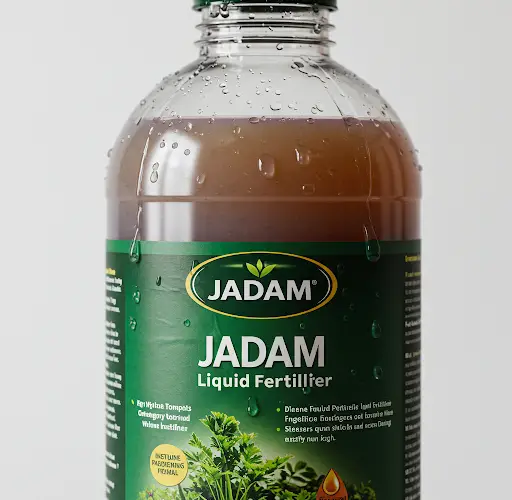JADAM Liquid Fertilizer: A Powerful Organic Boost for Your Plants
Imagine giving your plants a drink so powerful, it’s like a magical potion—one that makes seedlings grow thick and strong, helps mature plants bloom with vitality, and supercharges overall plant health. That’s the idea behind JADAM liquid fertilizer—a natural, nutrient-dense plant tonic made from organic materials and beneficial microorganisms. Easy to make at home, this liquid fertilizer offers far more than conventional store-bought options.
Whether you’re growing vegetables, flowers, or fruit trees, JADAM liquid fertilizer (JLF) can be used throughout a plant’s life—from early seedling stages to full maturity. Let’s explore what makes this organic fertilizer so effective, and how you can easily make it yourself with simple ingredients and tools.
What Is JADAM Liquid Fertilizer?
JADAM liquid fertilizer is a fermented plant extract made using an anaerobic process (without oxygen) called putrefaction. It involves soaking organic materials—such as weeds, leaves, or grass—in water, then introducing microorganisms from leaf mold to initiate fermentation. Over the course of 1 to 2 weeks, the organic matter breaks down, releasing a rich blend of nutrients, hormones, amino acids, and beneficial microbes.
Unlike synthetic fertilizers, which may feed plants but degrade soil health over time, JLF nourishes both plants and the soil. It’s rich in nitrogen, phosphorus, and potassium, along with a host of other natural compounds that promote vigorous growth, strong root systems, and better resistance to stress and disease.
Ingredients You’ll Need
To make JADAM liquid fertilizer, you only need three basic ingredients:
-
Organic material (grasses, weeds, crop residues)
-
Leaf mold (a source of native microbes)
-
Non-chlorinated water
Let’s break each one down.
1. Organic Material
You can use a wide variety of plant matter—cut weeds, grass clippings, spent crops, or wild plants. Avoid using diseased plants or anything sprayed with herbicides. Chop large pieces for faster fermentation, although this is optional.
2. Leaf Mold
Leaf mold is the dark, crumbly, earthy material found underneath decaying leaves in forested areas. It’s rich in native soil microbes, which are essential for the fermentation process. Just a couple handfuls of leaf mold can kick-start your JLF and ensure a diverse microbial community.
3. Non-Chlorinated Water
Chlorinated tap water can harm beneficial microbes, so it’s best to use rainwater, river water, or dechlorinated tap water. If tap water is your only option, let it sit uncovered for 24 hours to allow the chlorine to dissipate.
How to Make JADAM Liquid Fertilizer
Follow these simple steps to create your own batch of JLF:
-
Fill a 5-gallon bucket with your chopped or whole plant materials, leaving about 3 inches of space from the top.
-
Add a handful or two of leaf mold on top of the plant material.
-
Pour non-chlorinated water into the bucket until the contents are fully submerged.
-
Cover loosely with a lid or breathable cloth to allow air exchange but keep pests out.
-
Place the bucket in a warm, shaded area—ideally somewhere out of direct sunlight.
-
Stir the mixture daily to promote even fermentation and help oxygenate the contents slightly, which can speed up the breakdown process.
After 1 to 2 weeks, depending on ambient temperature, the mixture should turn dark and develop a strong, fermented smell—this means it’s ready to use.
Strain and Store
Once fermentation is complete:
-
Strain the liquid through a mesh or cloth to remove solid particles.
-
Store the filtered liquid in airtight containers in a cool, dark place. It can remain effective for several months if stored properly.
How to Use JADAM Liquid Fertilizer
Before applying, always dilute the JLF with water to avoid overfeeding your plants. A general rule of thumb is:
-
1 part JLF to 20 parts water
This dilution ratio is safe for most plants, but it can be adjusted depending on your plant’s stage of growth or nutrient needs.
You can apply the diluted fertilizer in several ways:
-
As a soil drench around the base of plants
-
Through drip irrigation systems
-
As a foliar spray, though filtering through a fine mesh is necessary to prevent clogging sprayers
Apply every 7 to 14 days during the growing season for best results.
Benefits of JADAM Liquid Fertilizer
-
Improves soil fertility and microbial diversity
-
Encourages robust, healthy growth
-
Boosts resistance to pests and diseases
-
Supports root development, flowering, and fruiting
-
Reduces garden waste by recycling organic materials
-
Environmentally safe and cost-effective
Final Thoughts
JADAM liquid fertilizer is more than just plant food—it’s a complete, living solution for building healthier plants and soil. With just a bucket, some weeds, and a bit of patience, you can create a powerful organic fertilizer that helps your garden thrive naturally.
Whether you’re a home gardener or small-scale farmer, incorporating JLF into your routine can make a noticeable difference in plant vigor, yield, and long-term soil health.



